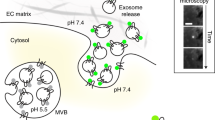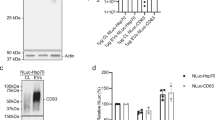Abstract
Early endosomes receive material from the plasma membrane by fusion with endocytotic vesicles. This material is sorted within endosomes and directed to subdomains at which carrier vesicles bud. These vesicles are then transported toward different cellular destinations. In this article, we describe a protocol for the cell-free reconstitution of endosome docking/fusion and sorting/budding, which is based on labeling of endosomes by endocytotic uptake with fluorescent cargoes. The protocol includes (i) the preparation of fluorescently labeled endosomes, (ii) assays for docking/fusion and for sorting/budding in vitro and (iii) imaging of the reaction mix by fluorescence microscopy to quantify docking, fusion, cargo sorting and budding using counting of single organelles. Production of endosome stocks requires approximately 1 d. The in vitro reactions can then be performed separately (∼1 d) and are conveniently carried out with multiple samples in parallel. The assay can be adapted for studying the dynamics of organelles other than endosomes.
This is a preview of subscription content, access via your institution
Access options
Subscribe to this journal
Receive 12 print issues and online access
$259.00 per year
only $21.58 per issue
Buy this article
- Purchase on Springer Link
- Instant access to full article PDF
Prices may be subject to local taxes which are calculated during checkout



Similar content being viewed by others
References
Gruenberg, J. & Howell, K.E. Membrane traffic in endocytosis: insights from cell-free assays. Annu. Rev. Cell Biol. 5, 453–481 (1989).
Pagano, A., Crottet, P., Prescianotto-Baschong, C. & Spiess, M. In vitro formation of recycling vesicles from endosomes requires adaptor protein-1/clathrin and is regulated by rab4 and the connector rabaptin-5. Mol. Biol. Cell 15, 4990–5000 (2004).
Prekeris, R., Klumperman, J., Chen, Y.A. & Scheller, R.H. Syntaxin 13 mediates cycling of plasma membrane proteins via tubulovesicular recycling endosomes. J. Cell Biol. 143, 957–971 (1998).
Desnos, C., Clift-O′Grady, L. & Kelly, R.B. Biogenesis of synaptic vesicles in vitro. J. Cell Biol. 130, 1041–1049 (1995).
Clift-O′Grady, L. et al. Reconstitution of synaptic vesicle biogenesis from PC12 cell membranes. Methods 16, 150–159 (1998).
Lichtenstein, Y., Desnos, C., Faundez, V., Kelly, R.B. & Clift-O'Grady, L. Vesiculation and sorting from PC12-derived endosomes in vitro. Proc. Natl Acad. Sci. USA 95, 11223–11228 (1998).
Lim, S.N. et al. Identification of discrete classes of endosome-derived small vesicles as a major cellular pool for recycling membrane proteins. Mol. Biol. Cell 12, 981–995 (2001).
de Wit, H. et al. Rab4 regulates formation of synaptic-like microvesicles from early endosomes in PC12 cells. Mol. Biol. Cell 12, 3703–3715 (2001).
Brandhorst, D. et al. Homotypic fusion of early endosomes: SNAREs do not determine fusion specificity. Proc. Natl Acad. Sci. USA 103, 2701–2706 (2006).
Geumann, U., Barysch, S.V., Hoopmann, P., Jahn, R. & Rizzoli, S.O. SNARE function is not involved in early endosome docking. Mol. Biol. Cell 19, 5327–5337 (2008).
Bethani, I. et al. Endosomal fusion upon SNARE knockdown is maintained by residual SNARE activity and enhanced docking. Traffic 10, 1543–1559 (2009).
Barysch, S.V., Aggarwal, S., Jahn, R. & Rizzoli, S.O. Sorting in early endosomes reveals connections to docking- and fusion-associated factors. Proc. Natl Acad. Sci. USA 106, 9697–9702 (2009).
Rizzoli, S.O. et al. Evidence for early endosome-like fusion of recently endocytosed synaptic vesicles. Traffic 7, 1163–1176 (2006).
Balch, W.E. & Rothman, J.E. Characterization of protein transport between successive compartments of the Golgi apparatus: asymmetric properties of donor and acceptor activities in a cell-free system. Arch. Biochem. Biophys. 240, 413–425 (1985).
Lang, T. Imaging Ca2+-triggered exocytosis of single secretory granules on plasma membrane lawns from neuroendocrine cells. Methods Mol. Biol. 440, 51–59 (2008).
Bradford, M.M. A rapid and sensitive method for the quantitation of microgram quantities of protein utilizing the principle of protein-dye binding. Anal. Biochem. 72, 248–254 (1976).
Davis, J.M. Basic Cell Culture (Practical Approach Series) Edn. 2. (Oxford University Press, 2002).
Russ, J.C. The Image Processing Handbook Edn. 5. (CRC Press, 2006).
Acknowledgements
We thank D. Brandhorst, D. Zwilling, U. Geumann and I. Bethani for the contribution to the development of the method presented in this study. We thank M. Lengauer and F. Kötting for the help with the ball homogenizer. This work was supported by grants from the Deutsche Forschungsgemeinschaft (SFB 523 and SFB 803) to R.J. S.V.B. has been the recipient of a fellowship of the International Max Planck Research School 'Molecular Biology'.
Author information
Authors and Affiliations
Contributions
S.V.B., R.J. and S.O.R. conceived the experimental strategy; S.V.B. and S.O.R. designed the experiments; S.V.B. and S.O.R. conducted the experiments; S.V.B., R.J. and S.O.R. wrote the article.
Corresponding author
Ethics declarations
Competing interests
The authors declare no competing financial interests.
Rights and permissions
About this article
Cite this article
Barysch, S., Jahn, R. & Rizzoli, S. A fluorescence-based in vitro assay for investigating early endosome dynamics. Nat Protoc 5, 1127–1137 (2010). https://doi.org/10.1038/nprot.2010.84
Published:
Issue Date:
DOI: https://doi.org/10.1038/nprot.2010.84
This article is cited by
-
Rab GTPases and phosphoinositides fine-tune SNAREs dependent targeting specificity of intracellular vesicle traffic
Nature Communications (2024)
-
Antibody-driven capture of synaptic vesicle proteins on the plasma membrane enables the analysis of their interactions with other synaptic proteins
Scientific Reports (2019)
-
A novel AHI-1–BCR-ABL–DNM2 complex regulates leukemic properties of primitive CML cells through enhanced cellular endocytosis and ROS-mediated autophagy
Leukemia (2017)
-
Numb regulates vesicular docking for homotypic fusion of early endosomes via membrane recruitment of Mon1b
Cell Research (2016)
Comments
By submitting a comment you agree to abide by our Terms and Community Guidelines. If you find something abusive or that does not comply with our terms or guidelines please flag it as inappropriate.



